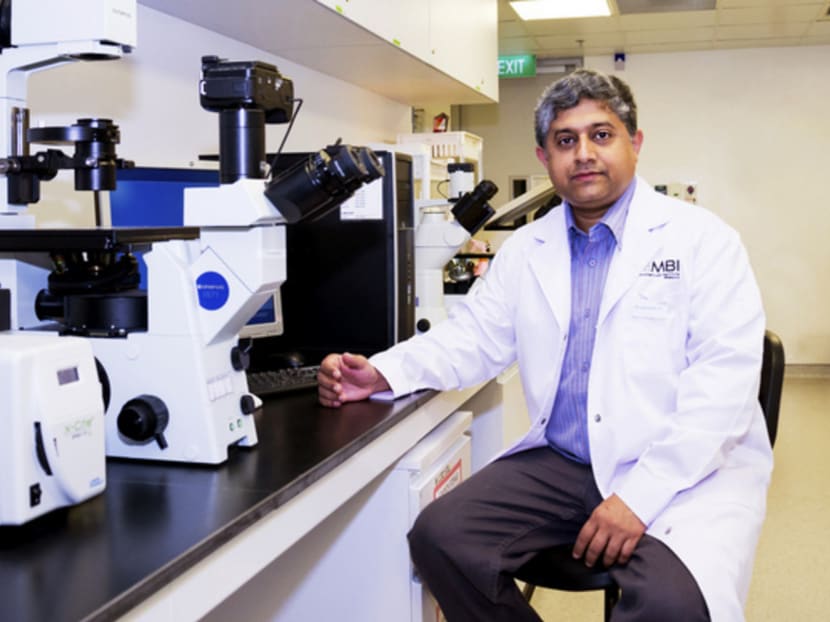Study to detect cancer before symptoms develop shows promise
SINGAPORE — A new collaborative study between a Singapore institute and an Italian cancer research centre is working to detect and prevent cancer before any symptoms can develop, with a new discovery having shed light on how a protein could be triggered to protect DNA from being damaged.

Professor G V Shivashankar’s team is now working on
fully understanding how mechanical forces can trigger a
biological response. Photo: Mechanobiology Institute of Singapore
SINGAPORE — A new collaborative study between a Singapore institute and an Italian cancer research centre is working to detect and prevent cancer before any symptoms can develop, with a new discovery having shed light on how a protein could be triggered to protect DNA from being damaged.
The team, led by Professor G V Shivashankar from the National University of Singapore, has been observing how damage to DNA within our cells — specifically caused by mechanical stresses such as when cells get squeezed or compressed when they move around in our body — leads to cancer.
In the process, they discovered that physical forces, such as stretching or changing a cell’s shape, could also trigger a protein that can sense and protect DNA from being damaged. While the protein’s role in the prevention of DNA damage is well known, the role of mechanical forces in its regulation took the researchers by surprise.
This discovery took them into unfamiliar territory: What was once thought to be a primarily biochemical process (the activation of the protein) could be regulated by basic physics.
This opens an exciting new phase for future therapeutic models for cancer, said Prof Shivashankar, although he noted that finding ways to detect cancer before symptoms show could take years to accomplish.
The team is now working on fully understanding how mechanical forces can trigger a biological response, he said.
The team is from a joint research laboratory formed by the Mechanobiology Institute in Singapore — one of five Research Centres of Excellence set up by the National Research Foundation and the Ministry of Education — and the Italian Foundation for Cancer Research’s Institute of Molecular Oncology. Prof Shivashankar, who has a background in physics, biology and engineering, heads the joint reseach laboratory.
Prof Shivashankar said the team now has “very precise readouts” on how DNA is packed in a normal cell, how the packing is critical to establish a particular given gene expression programme and how changes in the packing then alters gene expression.
“For a long time, everyone thought that a cell’s nucleus was like a box where you pack DNA like a spaghetti and it doesn’t matter how you pack it. But more recently in the past 10 to 15 years, one realises that how you pack DNA in the nucleus, how you arrange them in this nuclear architecture, has a huge role in how you regulate information in DNA, how you copy proteins, how you replicate DNA, how you repair DNA,” he said.
With the readouts or biomarkers, one could potentially take a single cell sample, observe very early on for small changes in the DNA packing and then repair the mutation by triggering the relevant protein.
“There is a huge possibility now to build early diagnostics as close to the normal state (before any symptoms develop),” said Prof Shivashankar.
One limitation currently, however, is the kind of cells that can be tested.
“If you want to test epithelial cells (which are responsible for 85 per cent of all cancers), it’s easy to get samples from tissues. Blood cells are also easy to get. But collecting other cell types require precise procedures and protocols,” Prof Shivashankar said.
Still, he has a long-term vision on how his research could be used in the future for everyone to detect cancer.
“There are a number of global health initiatives in the world to build miniaturised test kits and we are looking at that for the future,” he said.
“In fact, one of my colleagues at Stanford University has created a microscope on a thin paper sheet ... you can look at individual cells very nicely.”
“The test will be simple if we succeed in this venture … You should be able to just pinch a small blood or tissue sample from yourself and look at the packing patterns.”
Cancer is the No 1 cause of death in Singapore. Data from the Ministry of Health showed that nearly one in three deaths (30.5 per cent) in Singapore last year were caused by the disease.





